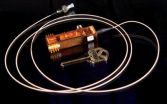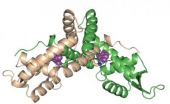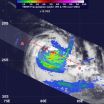(Press-News.org) EAST LANSING, Mich. — In what could be an early step toward new treatments for people with osteoporosis, scientists at Michigan State University report that a natural probiotic supplement can help male mice produce healthier bones.
Interestingly, the same can't be said for female mice, the researchers report in the Journal of Cellular Physiology.
"We know that inflammation in the gut can cause bone loss, though it's unclear exactly why," said lead author Laura McCabe, a professor in MSU's departments of Physiology and Radiology. "The neat thing we found is that a probiotic can enhance bone density."
Probiotics are microorganisms that can help balance the immune system. For the study, the researchers fed the mice Lactobacillus reuteri, a probiotic known to reduce inflammation, a sometimes harmful effect of the body's immune response to infection.
"Through food fermentation, we've been eating bacteria that we classify as probiotics for thousands of years," said co-author Robert Britton, associate professor in the Department of Microbiology and Molecular Genetics. "There's evidence that this bacterium as a species has co-evolved with humans. It's indigenous to our intestinal tracts and is something that, if missing, might cause problems."
In the study, the male mice showed a significant increase in bone density after four weeks of treatment. There was no such effect when the researchers repeated the experiment with female mice, an anomaly they're now investigating.
By 2020, half of all Americans over 50 are expected to have low bone density or osteoporosis, according to the National Osteoporosis Foundation. About one in two women and one in four men over 50 will break a bone due to osteoporosis.
Drugs to prevent bone loss in osteoporosis patients are already in wide use, but over the long term they can disrupt the natural remodeling of bone tissue and could potentially have negative side effects that include unusual bone fractures and joint and muscle pain.
McCabe and Britton are quick to point out that this line of research is in its early stages and that results in mice don't always translate to humans. But they're hopeful the new study could point the way toward osteoporosis drugs that aren't saddled with such side effects, especially for people who lose bone density from an early age because of another chronic condition.
"People tend to think of osteoporosis as just affecting postmenopausal women, but what they don't realize is that it can occur with other conditions such as inflammatory bowel disease and Type 1 diabetes," she said. "You don't want to put your child on medications that reduce bone remodeling for the rest of their life, so something natural could be useful for long-term treatment of bone loss that begins at childhood."
###
The research was supported by grants from the National Institutes of Health and MSU. Research assistants Regina Irwin and Laura Schaefer co-authored the paper.
Michigan State University has been working to advance the common good in uncommon ways for more than 150 years. One of the top research universities in the world, MSU focuses its vast resources on creating solutions to some of the world's most pressing challenges, while providing life-changing opportunities to a diverse and inclusive academic community through more than 200 programs of study in 17 degree-granting colleges.
For MSU news on the Web, go to MSUToday. Follow MSU News on Twitter at twitter.com/MSUnews.
Building healthy bones takes guts
Probiotic boosts bone density in mice, could point way to new, natural treatments for osteoporosis
2013-02-15
ELSE PRESS RELEASES FROM THIS DATE:
New methodology to predict pandemics
2013-02-15
NEW YORK – February 13, 2013 – EcoHealth Alliance, the nonprofit organization that focuses on local conservation and global health issues, announced new research focused on the rapid identification of disease outbreaks in the peer reviewed publication, Journal of the Royal Society Interface. The article, authored by leading scientists in the fields of emerging disease ecology, biomathematics, computational biology and bioinformatics, shows how network theory can be used to identify outbreaks of unidentified diseases. The strategy builds on the wealth of online surveillance ...
Quantum cryptography put to work for electric grid security
2013-02-15
LOS ALAMOS, N.M., Feb. 14, 2013—A Los Alamos National Laboratory quantum cryptography (QC) team has successfully completed the first-ever demonstration of securing control data for electric grids using quantum cryptography.
The demonstration was performed in the electric grid test bed that is part of the Trustworthy Cyber Infrastructure for the Power Grid (TCIPG) project at the University of Illinois Urbana-Champaign (UIUC) that was set up under the Department of Energy's Cyber Security for Energy Delivery Systems program in the Office of Electricity Delivery and Energy ...
A microbial biorefinery provides new insight into how bacteria regulate genes
2013-02-15
PROVIDENCE, R.I. [Brown University] — Microorganisms that can break down plant biomass into the precursors of biodiesel or other commodity chemicals might one day be used to produce alternatives to petroleum. But the potential of this "biorefinery" technology is limited by the fact that most microorganisms cannot break down lignin, a highly stable polymer that makes up as much as a third of plant biomass.
Streptomyces bacteria are among few microorganisms known to degrade and consume lignin. Now a group of researchers at Brown University has unlocked the genetic and molecular ...
NASA's Fermi proves supernova remnants produce cosmic rays
2013-02-15
A new study using observations from NASA's Fermi Gamma-ray Space Telescope reveals the first clear-cut evidence the expanding debris of exploded stars produces some of the fastest-moving matter in the universe. This discovery is a major step toward understanding the origin of cosmic rays, one of Fermi's primary mission goals.
"Scientists have been trying to find the sources of high-energy cosmic rays since their discovery a century ago," said Elizabeth Hays, a member of the research team and Fermi deputy project scientist at NASA's Goddard Space Flight Center in Greenbelt, ...
Researchers discover breakthrough in ovarian cancer
2013-02-15
(Phoenix, AZ Feb. 14, 2014) -- Researchers at The University of Arizona Cancer Center at St. Joseph's Hospital and Medical Center in Phoenix have discovered that many women with low-grade serous carcinoma of the ovary or peritoneum have seen their tumors stabilize or shrink after taking a regular dose of the compound selumetinib.
The findings, published in the Feb. 14 edition of The Lancet Oncology, show that selumetinib targets a mutation in the MAPK pathway for patients with low-grade serous carcinoma, allowing for treatment on previously chemoresistant tumors.
"This ...
NASA satellite sees Cyclone Gino's rainfall shoved southward
2013-02-15
NASA's Tropical Rainfall Measuring Mission satellite known as TRMM measured Cyclone Gino's rainfall from space and saw the bulk of precipitation was south of the center. Gino's rainfall is being pushed away from the center by vertical wind shear.
TRMM flew over Cyclone Gino on Thursday, Feb. 14 at 0806 UTC (3:06 a.m. EST) and measured the rainfall rates occurring throughout the storm. The bulk of the rainfall stretched from south to southeast of the center. The heaviest rain was falling at a rate of 2 inches (50 mm) per hour southeast of the center, and scattered throughout ...
Prevention efforts focused on youth reduce prescription abuse into adulthood
2013-02-15
Middle school students from small towns and rural communities who received any of three community-based prevention programs were less likely to abuse prescription medications in late adolescence and young adulthood. The research, published today in the American Journal of Public Health, was funded by the National Institute on Drug Abuse (NIDA), the National Institute on Alcohol Abuse and Alcoholism, and the National Institute of Mental Health, all components of the National Institutes of Health.
"Prescription medications are beneficial when used as prescribed to treat ...
Research finds promising approaches to prevent Latino childhood obesity
2013-02-15
San Diego, CA, February 15, 2013 – Guided grocery store trips, menu labeling at restaurants, community gardens, and video-game-based exercise programs are among several promising, culturally appropriate ways to prevent obesity among Latino children, according to a new collection of studies from Salud America! The Robert Wood Johnson Foundation Research Network to Prevent Obesity Among Latino Children published in a supplement to the March issue of the American Journal of Preventive Medicine.
Salud America! is a national network of researchers, advocates, and policymakers ...
Moffitt researchers find potential new therapeutic target for treating non-small cell lung cancer
2013-02-15
Researchers at Moffitt Cancer Center have found a potential targeted therapy for patients with tobacco-associated non-small cell lung cancer. It is based on the newly identified oncogene IKBKE, which helps regulate immune response.
The study appeared in the Feb. 13 online issue of Oncogene.
The IKBKE gene is part of a family of enzyme complexes involved in increasing cellular inflammation. IKBKE overexpression has been associated with breast and prostate cancers. However, it had not been linked to environmental carcinogen, such as tobacco smoke, until now.
Tobacco ...
Can police withdraw blood from DWI suspects without a warrant?
2013-02-15
Can police withdraw blood from DWI suspects without a warrant?
Article provided by Ellis & Ortega, LLC
Visit us at http://www.theortegalawgroup.com
In early 2013, the Supreme Court of the United States will hear a case regarding the constitutionality of law enforcement drawing blood from a drunken driving suspect without first obtaining a warrant. At the heart of the case is whether blood tests without a warrant violate the Fourth Amendment's protection from unreasonable search and seizure.
The history of the Supreme Court case
The case the Supreme Court ...
LAST 30 PRESS RELEASES:
Making lighter work of calculating fluid and heat flow
Normalizing blood sugar can halve heart attack risk
Lowering blood sugar cuts heart attack risk in people with prediabetes
Study links genetic variants to risk of blinding eye disease in premature infants
Non-opioid ‘pain sponge’ therapy halts cartilage degeneration and relieves chronic pain
AI can pick up cultural values by mimicking how kids learn
China’s ecological redlines offer fast track to 30 x 30 global conservation goal
Invisible indoor threats: emerging household contaminants and their growing risks to human health
Adding antibody treatment to chemo boosts outcomes for children with rare cancer
Germline pathogenic variants among women without a history of breast cancer
Tanning beds triple melanoma risk, potentially causing broad DNA damage
Unique bond identified as key to viral infection speed
Indoor tanning makes youthful skin much older on a genetic level
Mouse model sheds new light on the causes and potential solutions to human GI problems linked to muscular dystrophy
The Journal of Nuclear Medicine ahead-of-print tip sheet: December 12, 2025
Smarter tools for peering into the microscopic world
Applications open for funding to conduct research in the Kinsey Institute archives
Global measure underestimates the severity of food insecurity
Child survivors of critical illness are missing out on timely follow up care
Risk-based vs annual breast cancer screening / the WISDOM randomized clinical trial
University of Toronto launches Electric Vehicle Innovation Ontario to accelerate advanced EV technologies and build Canada’s innovation advantage
Early relapse predicts poor outcomes in aggressive blood cancer
American College of Lifestyle Medicine applauds two CMS models aligned with lifestyle medicine practice and reimbursement
Clinical trial finds cannabis use not a barrier to quitting nicotine vaping
Supplemental nutrition assistance program policies and food insecurity
Switching immune cells to “night mode” could limit damage after a heart attack, study suggests
URI-based Global RIghts Project report spotlights continued troubling trends in worldwide inhumane treatment
Neutrophils are less aggressive at night, explaining why nighttime heart attacks cause less damage than daytime events
Menopausal hormone therapy may not pose breast cancer risk for women with BRCA mutations
Mobile health tool may improve quality of life for adolescent and young adult breast cancer survivors
[Press-News.org] Building healthy bones takes gutsProbiotic boosts bone density in mice, could point way to new, natural treatments for osteoporosis



